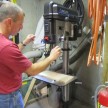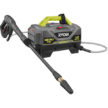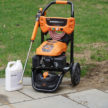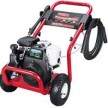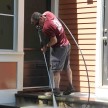Ryobi 3000 PSI 1.1 GPM Brushless Electric Pressure Washer
Ryobi 3000 PSI 1.1 GPM Brushless Electric Pressure Washer (#RY143011)

Washer Specifications:
- Residential rating
- Corded electric motor (13 amps)
- 39 pounds in weight
- Powerful brushless motor
- Up to 3000 PSI and 1.1 GPM
- Axial pump type
- Included 5-in-1 Nozzle to customize spray pattern for the task
- Included Turbo Nozzle for faster cleaning
- On-board accessory storage and cord storage
- 35-foot non-marring high-pressure hose
- On-board detergent tank for easy soap application
- Hand truck frame and large 12-inch flat-free wheels for easy transport
- Metal spray wand with 1/4 in. quick connect capability
- 3-year limited tool warranty
- Available for purchase at The Home Depot
Owning a home requires a lot of cleaning, both inside and outside the house. I have always used the Ryobi Power Scrubber and the Ryobi EZClean Power Cleaner when I had outdoor cleaning projects to complete. Both Ryobi tools have worked well for all of the tasks I tackled, but neither one had the power to clean the most stubborn and embedded dirt. When I was given the opportunity to test the Ryobi 3000 PSI 1.1 GPM Brushless Electric Pressure Washer (#RY143011), I finally had the powerful cleaning solution for the most difficult maintenance projects my house could throw at me. At 3000 PSI, the Ryobi Pressure Washer blasts away dirt, grime, mold, and mildew with ease.
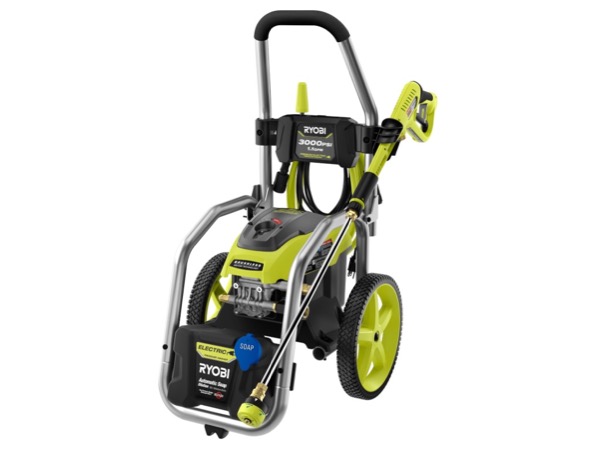
Some Assembly Required
The Ryobi Brushless Electric Pressure Washer arrives in a large box and does require approximately 10 minutes to complete its assembly. First, the two 12-inch diameter wheels need to be installed on the washer. Using the axles, hitch pins, and washers, the two wheels can be installed easily. After that, the handle needs to be folded back up—it was ‘down’ for shipping purposes. Raising the handle will enable the handle release knob to insert itself through the locking hole. Once this work is completed, the Pressure Washer can be easily wheeled into a location for work to commence.

Included High-Pressure Hose
Ryobi ships the Brushless Electric Pressure Washer with a bright yellow 35-foot non-marring high-pressure hose. Each end of the hose has a large black screw-on connector. The ridges on the connector make it very easy to grasp it firmly when attaching it to the trigger or motor. The hose also has a 3-inch rubber collar at each end to protect the connector when it is being twisted during application.

The hose itself is easily attached to the brass coupling on the motor–both brass hose connections on the motor are heavy-duty in nature. Once both ends of the high-pressure hose were connected securely, I never experienced a leak at either end. At 35 feet long, the hose was more than long enough to reach locations across my yard. After multiple hours of usage, the hose exhibited no signs of stress whatsoever. I am quite confident the hose and the connections are durable enough to last for years.

An issue that I did have with the hose was frequent kinking. The hose would often kink in multiple locations throughout my usage. The hose would bend and twist on itself and because the hose was so rigid, it was difficult to untangle. I have read other online reviewers also comment on how the hose is frequently kinked. If Ryobi could fix this issue and make the hose more flexible, that would be very helpful.
Convenient Features Built-In To the Truck
The metal hand truck frame that transports the pressure washer across your yard has many convenient features. The large 12-inch diameter rear tires on the truck make it very easy to roll the tool across uneven terrain. The tires are plastic, so they will never require any air. The metal frame of the truck is very solid and 1.25-inches in diameter. The handle on the truck is also 1.25” in diameter and the top of it rises to 3 feet off the ground. I really liked the tall handle since it didn’t require me to bend over when I tilted the truck back and rolled it across my yard. A nice touch was the addition of thick black foam onto the handle for extra cushioning on your hands.
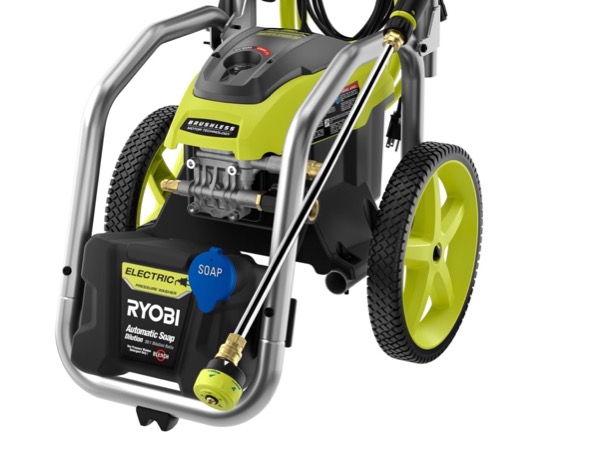
The handle’s locking pin can be disengaged so the entire upper handle assembly can be lowered to facilitate storage and transportation. Thank you to the Ryobi engineers for designing a folding handle since the pressure washer would never have fit in the back of my Subaru if the handle didn’t fold down.

Below the upper handle, Ryobi added two holes atop the accessory holder to store the nozzles when they were not in use. Between the nozzle storage, there is a Velcro strap that allows you to safely secure the electrical cord after it has been wound up. To the left of that, there is a holster to store the trigger nozzle and attached spray wand.

A final convenient feature is also a significant safety feature. On the trigger handle, Ryobi intelligently installed a lock-out lever. When the lock-out lever is folded down and engaged, the trigger can no longer be squeezed to operate the washer. Anyone with young children at home will appreciate this safety feature a great deal since water sprayed at 3000 PSI could cause a serious injury if a young child mistakenly operated it.

Quiet Operation
The Ryobi Brushless Electric Pressure Washer operates very quietly, unlike many gas pressure washers that I have heard running in my neighborhood. While cleaning your property needs to be done, it doesn’t need to be done at excessive volumes. Once turned on, the Ryobi electric motor can be heard “humming”. The engine noise never stops, even when the water is not being used. However, at 64 decibels, it is not going to disturb your neighbors when it is “idling”. Once I began cleaning with the Ryobi Pressure Washer, the decibels from the electric motor averaged 72-78 decibels, measured at 5 feet above the ground.
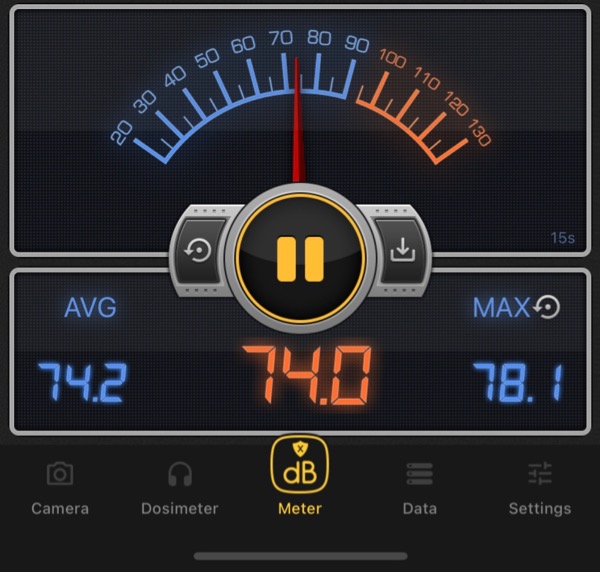
When I measured the decibel level of the turbo nozzle while it was spraying, it averaged 82-86 decibels. When compared to a typical gas pressure washer that operates at 85-105 decibels, the Ryobi Pressure Washer is significantly less noisy, actually up to 100 times less noisy! A quieter tool will certainly improve your working experience, and it will also not disturb your neighbors. As a precaution, ear protection is still recommended for most tools that operate above 85 decibels.
Soap Tank
The Ryobi Pressure Washer includes a large soap tank on the front of the unit. This soap tank can be used with most detergents designed for pressure washers. Ryobi strongly advises against using bleach inside the soap tank since it will harm the pump. Ryobi has the machine set to a 20:1 ratio, which usually allows 1 gallon of detergent without further dilution. Once the soap tank is prepared, you need to install the 5-in-1 change-over nozzle. I really appreciated having 5 unique spray pattern options available on one spray head. The quick-connect capability on the wand head and the 2 different spray heads were both very convenient options.

I used both the short-range detergent and long-range detergent settings on the 5-in-1 nozzle. Within seconds of starting the electric motor, the car wash solution in the soap tank produced brilliant white suds all over the car.
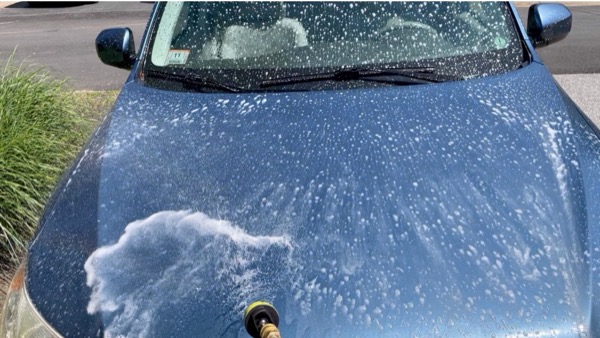
The water pressure was significantly less on these 2 settings, allowing the soap to clean the dirt off my car (some manual scrubbing was still required). Using the 40-degree setting on the 5-in-1 nozzle was perfect for rinsing the soap. I appreciated the inclusion of a soap tank since it increased the usefulness of the pressure washer. I look forward to using this feature to wash my shed before staining it again this fall.
Click here for a video of the car being washed on the soap setting.
The Electric Motor Delivers Powerful Cleaning
The premium brushless electric induction motor delivers 3000 PSI of power while only using 1.1 gallons of water per minute. Ryobi also designed the brushless motor with water-cooling technology to increase the tool’s efficiency. When you have that much power operating at only 82-86 decibels, you have tremendous cleaning potential in your hands.

When I unleashed the Ryobi Pressure Washer on the concrete stairs at my home and my parent’s summer home, it effortlessly blasted away the dirt. The Turbo mode nozzle provides a concentrated stream of water that destroys dirt. In Turbo mode, it was able to remove dirt and grime immediately from the stair treads.
Click here to see a video of the Turbo nozzle in action.
There was a great deal of dirt and lichen that had accumulated on some 4×4 pressure-treated landscape timbers. They had not been cleaned in more than 10 years. The Turbo mode easily removed all of the dirt and lichen and made them look like new again.

Click here to see a video of the dirt being removed from the 4×4 pressure-treated wood.
I also used the Turbo mode to blast off old, flaking black paint and dirt from the metal stair railings before we painted them again. The pressure washer made the preparation time so much faster since I didn’t need to use a wire brush to remove the old paint.
When I used the 5-in-1 nozzle, the 15-degree setting provided a wider stream of water that also cleared dirt with little effort. The 25-degree and 40-degree settings also did a nice job cleaning, but I felt they were better for rinsing off surfaces.
Click Here to see a video of the 40-degree setting in action.
The Turbo nozzle is definitely the go-to tool for the most stubborn dirt. Both my wife and son loved using the pressure washer too because the results were immediate and quite gratifying.

At 3000 PSI, the Ryobi Pressure Washer eradicated whatever dirt I presented it, all while only using 1.1 gallons of water per minute. My entire family was very impressed with its efficiency and effectiveness.

Before Cleaning

After Cleaning
Electrical Considerations
On the power cord itself, Ryobi includes a tag that states “If the pressure washer motor does not start or hesitates to start, there may not be sufficient power. Try another outlet.” I tested the Ryobi Pressure Washer in 3 different homes and I did experience some electrical complications in each home.
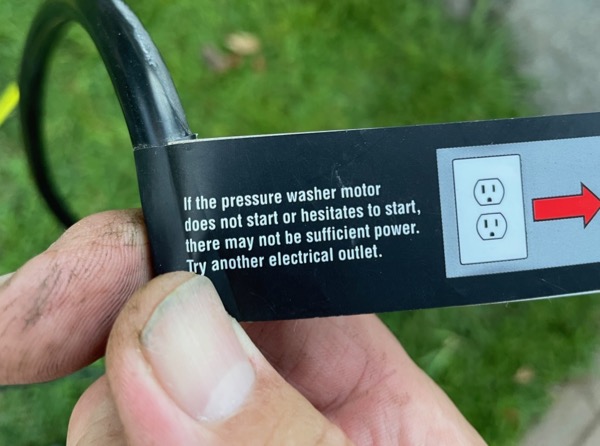
The electrical cord is 35 feet long and Ryobi does not recommend using an extension cord unless it is a heavy-duty 12-gauge cord less than 25 feet in length. At the end of the cord, a built-in GFCI box is included. In my time using the pressure washer, I found that the outlet I used in the house mattered a great deal. Here at my own home, we have 200-amp service and I rarely caused the built-in GFCI to trip. I was able to use the 2 electrical outlets outside my home, as well as the plugs inside my house.

After turning off the unit, occasionally I had to go inside my house and either “reset” the GFCI or unplug and re-plug the cord into the outlet to get the washer to turn on again. Once the green light on the GFCI was illuminated again, I was back in business.

I attempted to clean the concrete walkway at my parent’s house and I had a lot of difficulties. Their home has 100-amp service and it was built in the early 1970s. I was able to use the pressure washer for approximately 10 minutes on an outlet located inside their living room. After that, however, each and every outlet we tried to use caused the built-in GFCI to trip. When we tried one outlet, it caused the breaker to trip on the basement electrical box. We couldn’t find an outlet that had sufficient power to run the Ryobi Pressure Washer. If I had a heavy-duty extension cord, perhaps we would have been able to reach a 20-amp outlet inside the kitchen to try.
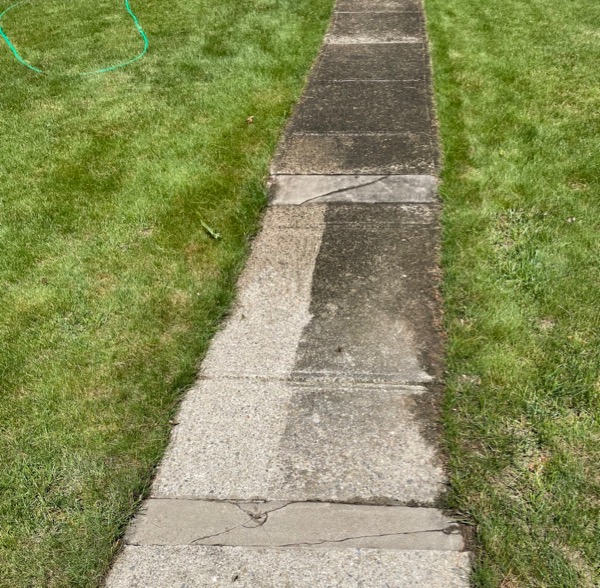
At the third house, I had no instances where the GFCI faulted. Most importantly, this was also a home with 100-amp service and it was built in 1995. My parent’s summer home in NH ran the Ryobi Pressure Washer without interruption for several hours. I was quite pleased that a home with 100-amp service could provide sufficient power for the unit.
At this time I feel I need to attribute the electrical problems at my parent’s home to older wiring that couldn’t provide a steady and adequate electrical power source. It was good that Ryobi acknowledges this need with a sticker attached to the electrical cord.
Final Impressions
I have always wanted an outdoor cleaning solution that didn’t also require me to exert my arms, legs, and back to get the job done. The Ryobi 3000 PSI 1.1 GPM Brushless Electric Pressure Washer is a very robust cleaning solution. It can effortlessly clear dirt, mold, mildew, algae, lichen, and other nasty grime from your house, shed, driveway, car, stairs, and patio. If you have a strong power source nearby, then I suggest you leave the gasoline machines behind and step up to the clean, quiet, and very powerful Ryobi Brushless Electric Pressure Washer.



